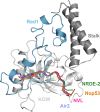The zinc-finger protein Red1 orchestrates MTREC submodules and binds the Mtl1 helicase arch domain
- PMID: 34103492
- PMCID: PMC8187409
- DOI: 10.1038/s41467-021-23565-3
The zinc-finger protein Red1 orchestrates MTREC submodules and binds the Mtl1 helicase arch domain
Abstract
Cryptic unstable transcripts (CUTs) are rapidly degraded by the nuclear exosome in a process requiring the RNA helicase Mtr4 and specific adaptor complexes for RNA substrate recognition. The PAXT and MTREC complexes have recently been identified as homologous exosome adaptors in human and fission yeast, respectively. The eleven-subunit MTREC comprises the zinc-finger protein Red1 and the Mtr4 homologue Mtl1. Here, we use yeast two-hybrid and pull-down assays to derive a detailed interaction map. We show that Red1 bridges MTREC submodules and serves as the central scaffold. In the crystal structure of a minimal Mtl1/Red1 complex an unstructured region adjacent to the Red1 zinc-finger domain binds to both the Mtl1 KOW domain and stalk helices. This interaction extends the canonical interface seen in Mtr4-adaptor complexes. In vivo mutational analysis shows that this interface is essential for cell survival. Our results add to Mtr4 versatility and provide mechanistic insights into the MTREC complex.
Conflict of interest statement
The authors declare no competing interests.
Figures







Similar articles
-
Mechanistic insights into RNA surveillance by the canonical poly(A) polymerase Pla1 of the MTREC complex.Nat Commun. 2023 Feb 11;14(1):772. doi: 10.1038/s41467-023-36402-6. Nat Commun. 2023. PMID: 36774373 Free PMC article.
-
Meiotic gene silencing complex MTREC/NURS recruits the nuclear exosome to YTH-RNA-binding protein Mmi1.PLoS Genet. 2020 Feb 3;16(2):e1008598. doi: 10.1371/journal.pgen.1008598. eCollection 2020 Feb. PLoS Genet. 2020. PMID: 32012158 Free PMC article.
-
Structural analysis of Red1 as a conserved scaffold of the RNA-targeting MTREC/PAXT complex.Nat Commun. 2022 Aug 24;13(1):4969. doi: 10.1038/s41467-022-32542-3. Nat Commun. 2022. PMID: 36002457 Free PMC article.
-
The fission yeast MTREC and EJC orthologs ensure the maturation of meiotic transcripts during meiosis.RNA. 2016 Sep;22(9):1349-59. doi: 10.1261/rna.055608.115. Epub 2016 Jun 30. RNA. 2016. PMID: 27365210 Free PMC article.
-
The Nuclear RNA Exosome and Its Cofactors.Adv Exp Med Biol. 2019;1203:113-132. doi: 10.1007/978-3-030-31434-7_4. Adv Exp Med Biol. 2019. PMID: 31811632 Review.
Cited by
-
Mechanistic insights into RNA surveillance by the canonical poly(A) polymerase Pla1 of the MTREC complex.Nat Commun. 2023 Feb 11;14(1):772. doi: 10.1038/s41467-023-36402-6. Nat Commun. 2023. PMID: 36774373 Free PMC article.
-
Finding new roles of classic biomolecular condensates in the nucleus: Lessons from fission yeast.Cell Insight. 2024 Aug 5;3(5):100194. doi: 10.1016/j.cellin.2024.100194. eCollection 2024 Oct. Cell Insight. 2024. PMID: 39228923 Free PMC article. Review.
-
Dual agonistic and antagonistic roles of ZC3H18 provide for co-activation of distinct nuclear RNA decay pathways.Cell Rep. 2023 Nov 28;42(11):113325. doi: 10.1016/j.celrep.2023.113325. Epub 2023 Oct 26. Cell Rep. 2023. PMID: 37889751 Free PMC article.
-
The human SKI complex regulates channeling of ribosome-bound RNA to the exosome via an intrinsic gatekeeping mechanism.Mol Cell. 2022 Feb 17;82(4):756-769.e8. doi: 10.1016/j.molcel.2022.01.009. Epub 2022 Feb 3. Mol Cell. 2022. PMID: 35120588 Free PMC article.
-
Extended N-Terminal Acetyltransferase Naa50 in Filamentous Fungi Adds to Naa50 Diversity.Int J Mol Sci. 2022 Sep 16;23(18):10805. doi: 10.3390/ijms231810805. Int J Mol Sci. 2022. PMID: 36142717 Free PMC article.
References
Publication types
MeSH terms
Substances
LinkOut - more resources
Full Text Sources

